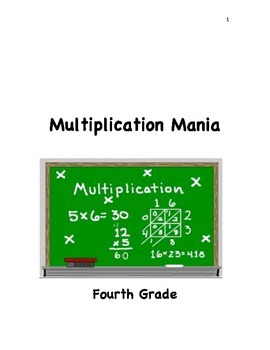4th Grade Multiplication Unit
A Big Heart Shaping Little Minds
14 Followers
Grade Levels
3rd - 5th
Subjects
Resource Type
Standards
CCSS4.OA.A.1
CCSS4.OA.A.2
CCSS4.OA.A.3
Formats Included
- PDF
Pages
54 pages
A Big Heart Shaping Little Minds
14 Followers
Description
-Fully developed unit plan for 4th grade students
-Common Core Standards & National Council of Teachers of Mathematics and Process Standards aligned
-Application of four operations - multiplication, division, addition and subtraction to solve problems
-Higher level thinking promoted
-Duration of 5 lessons including summative lesson & performance task
-Scripted lesson plans (objectives, materials, initiation, modeling, guided practice, independent practice, closure)
-Rubrics, samples of student work, differentiation for ELLs and special education, and activity sheets included
-Whole group, small group and individual
-Can be adapted for 3-5th grade
Please leave feedback :)
-Common Core Standards & National Council of Teachers of Mathematics and Process Standards aligned
-Application of four operations - multiplication, division, addition and subtraction to solve problems
-Higher level thinking promoted
-Duration of 5 lessons including summative lesson & performance task
-Scripted lesson plans (objectives, materials, initiation, modeling, guided practice, independent practice, closure)
-Rubrics, samples of student work, differentiation for ELLs and special education, and activity sheets included
-Whole group, small group and individual
-Can be adapted for 3-5th grade
Please leave feedback :)
Total Pages
54 pages
Answer Key
Included with rubric
Teaching Duration
N/A
Report this resource to TPT
Reported resources will be reviewed by our team. Report this resource to let us know if this resource violates TPT’s content guidelines.
Standards
to see state-specific standards (only available in the US).
CCSS4.OA.A.1
Interpret a multiplication equation as a comparison, e.g., interpret 35 = 5 × 7 as a statement that 35 is 5 times as many as 7 and 7 times as many as 5. Represent verbal statements of multiplicative comparisons as multiplication equations.
CCSS4.OA.A.2
Multiply or divide to solve word problems involving multiplicative comparison, e.g., by using drawings and equations with a symbol for the unknown number to represent the problem, distinguishing multiplicative comparison from additive comparison.
CCSS4.OA.A.3
Solve multistep word problems posed with whole numbers and having whole-number answers using the four operations, including problems in which remainders must be interpreted. Represent these problems using equations with a letter standing for the unknown quantity. Assess the reasonableness of answers using mental computation and estimation strategies including rounding.





